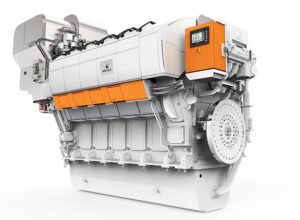
The Wärtsilä 31 engine, which has been recognised by Guinness World Records as being the world’s most efficient 4-stroke diesel engine, has been chosen as the main engine for a new purse seiner/trawler being built by the Danish shipbuilder Karstensen Shipyard. The ship will be owned by Peter Hepsø Rederi AS based in Norway. This will be the world’s first fishing vessel with the Wärtsilä 31 engine. In addition to the main engine, Wärtsilä will also supply the complete propulsion system comprising a 2-speed gearbox, controllable pitch propellers, nozzle, the Wärtsilä Propulsion Control System, and the shaft generator.
“Our company will be celebrating its 100 year anniversary in 2017. It is appropriate, therefore, that we mark the occasion with a new vessel that will represent the future of the fishing fleet. Wärtsilä’s propulsion solution provides the efficiency and environmental sustainability we needed for the ship,” says Audhild Hepsø, General Manager, Peter Hepsø Rederi AS. The 80 metre long purse seiner/trawler will primarily operate in the North Atlantic, the North Sea and in Norwegian waters.

The engine comes in three alternative versions; Diesel, Dual-Fuel (DF) and Spark-Ignited Gas (SG). The multi-fuel capabilities that this combustion engine brings to the market extend the possibilities for operators to utilise different qualities of fuels, from very light to very heavy diesel, and a range of different qualities of gas. The engine is designed to serve a variety of vessel types requiring main engine propulsion in the 4.2 to 9.8 MW power range. The remarkable increases in fuel efficiency and fuel flexibility that the Wärtsilä 31 brings to the market are matched by significant reductions in maintenance costs. As the company says the first service on this particular engine is required after only 8000 running hours.
The Wärtsilä 31 is available in 8V, 10V, 12V, 14V and 16V cylinder configurations. Among the many features of this engine are the latest developments in fuel injection systems, engine control systems, and charge air technologies. It is available for applications in mechanical drive installations, for producing electricity when coupled with a generator, for hybrid installations, as well as heavy duty installations or as an auxiliary engine.
Compared to a single mechanical propulsion system, a fuel consumption reduction of eight per cent was verified with the Wärtsilä 2-speed gearbox during sea trials. It is anticipated that further reductions of up to 15 per cent can be achieved, with a similar lowering of nitrogen oxide (NOx) and sulphur oxide (SOx) exhaust emissions.
These fuel cost savings and subsequent environmental benefits are achieved when the maximum vessel speed or propeller thrust is not required: When running the propeller at a reduced and more efficient speed closer to its design pitch, less power is required. At the same time, the engine speed is kept constant, thereby allowing the electric power generation from the gearbox Power Take-Off (PTO) to remain constant and also uninterrupted when switching between the 2 gear steps. Furthermore, by reducing the propeller speed there is a significant reduction in the underwater radiated noise level. This is of great importance for fishing- and seismic vessels and beneficial to marine life in general, while it is also highly appreciated by the crew due to less noise and vibration in the living quarters of the vessel.
Beitrag: Wärtsilä/PP



